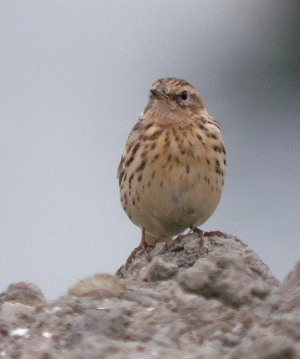- Anthus cervinus
Identification
14–15 cm (5½-6 in)
Breeding Male
Throats are various shades of red from pinkish to orangey to cherry-coloured. Bold brown streaks on flanks, strong white mantle stripes, black markings on a white background below. Face, throat, and upper breast are orange-brown. Crown is pale brown. Wings are brown with two white bars. Tail is white-edged.
Female, winter adult, and juvenile are duller.
Similar Species
Non breeding birds can be easily confused with Meadow Pipit and Pechora Pipit. The bold streaks, remaining broad and obvious on the flanks, unlike Tree Pipit and extending onto the rump unlike Meadow Pipit, very strong mantle lines, with white "braces"give the species a much more strongly marked appearance. Pechora Pipit which is superficially similar, shows a distinct primary projection, unlike Red-throated Pipit, though check all the tertials are there!
Best identified by its call[Call],
Distribution
Vagrant to the British Isles.
Taxonomy
This is a monotypic species[1].
Habitat
Open country including mountains, marshland and swampy tundra, often near the coast.
Behaviour
Breeding
They nest on the ground, in marshes, and 4-6 eggs are laid.
Diet
Its diet includes insects, but it also eats seeds.
Vocalisation
Call: A loud descending tsiiiiiiiiisssssssss similar in pitch to Redwing
References
- Clements, J. F., T. S. Schulenberg, M. J. Iliff, D. Roberson, T. A. Fredericks, B. L. Sullivan, and C. L. Wood. 2018. The eBird/Clements checklist of birds of the world: v2018. Downloaded from http://www.birds.cornell.edu/clementschecklist/download/
- Collins Field Guide 5th Edition
Recommended Citation
- BirdForum Opus contributors. (2025) Red-throated Pipit. In: BirdForum, the forum for wild birds and birding. Retrieved 14 May 2025 from https://www.birdforum.net/opus/Red-throated_Pipit
External Links
Search the Gallery using the scientific name:
Search the Gallery using the common name:
GSearch checked for 2020 platform.






